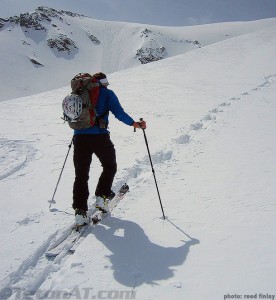 A couple weeks ago, I was able to do a fair bit of ski touring on the new 2011 Dynafit Radical FT binding due out this fall. Dynafit touts the Radical FT as a true step-in tech binding and includes it in it’s FreerideTouring category of bindings. The Radical FT has many nice improvements that cross over to the whole Radical line up (TLT Speed, ST and FT) and I could see mounting it on a ski setup to be used use at a resort and in the backcountry, or for skiing a resort like JHMR, where you might enjoy the benefits of a tech-style binding when outside the resort boundary, but also want some beef for when you enter back onto the piste. Here is a run down of some of the features of the Radical FT and my experiences with them.
A couple weeks ago, I was able to do a fair bit of ski touring on the new 2011 Dynafit Radical FT binding due out this fall. Dynafit touts the Radical FT as a true step-in tech binding and includes it in it’s FreerideTouring category of bindings. The Radical FT has many nice improvements that cross over to the whole Radical line up (TLT Speed, ST and FT) and I could see mounting it on a ski setup to be used use at a resort and in the backcountry, or for skiing a resort like JHMR, where you might enjoy the benefits of a tech-style binding when outside the resort boundary, but also want some beef for when you enter back onto the piste. Here is a run down of some of the features of the Radical FT and my experiences with them.
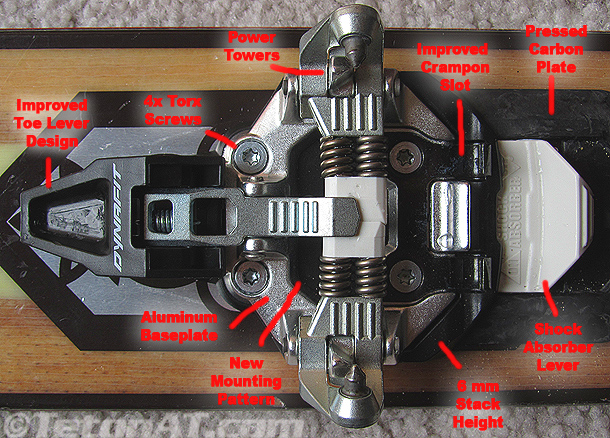
Dynafit Radical FT toe-piece.
Toe Piece
Improved Toe Lever Design– Now pointier in the front, the toe lever has a lower profile and also makes it harder to use the tip of your ski pole to push it down, which tended to inevitably chip the now, “older” levers. I was still able to knock the lever down with my ski pole tip, but it was harder and I can see why Dynafit is trying to keep people from doing it.
4x Torx Screws– Torx screws tend to be harder to strip and allow you to tighten screws down more. I’ve never had a problem with the old posi-drive type screws and mounting, but the torx screws should help in snugging down the base-plate, as there can be some issue with this when mounting if you are inexperienced at installing Dynafit bindings on your skis. I’m not sure why the heel-piece screws still remain posi-drive though…but they do. There are now only 4 screws (instead of 5) in the toe-piece as well…which simplifies things and helps shave weight.
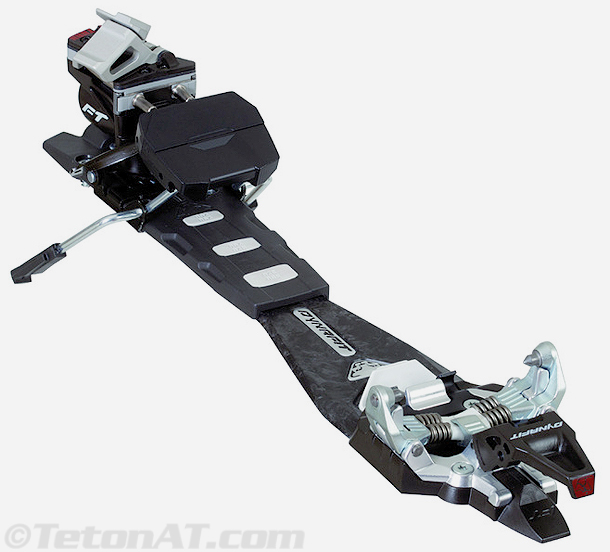
New Mounting Patten– The mounting screws on the toe-piece are spread out a bit more than the older Dynafit pattern. The rear two are in the same location relative to the pins and base-plate, but the front two are pushed forward a few millimeters. This still allows you to use the same rear holes when remounting to a ski that had 5-hole Dynafit bindings on them and you only have to drill new holes for the front screws. Though I’ve never had a Dynafit binding pull-out, this is bound to be an issue with the bigger boots and skis, and harder use people are putting tech bindings through these days, so a stronger mount is welcome.
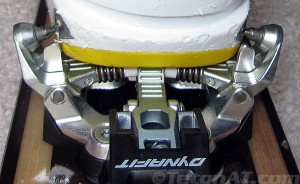 Power Towers– These static “towers†that are part of the base-plate add strength, rigidity and protection to the “wings†and pins on the toe-piece. They also make lining up the pins and sockets on your boots easier and allow for better step-in functionality…even with boots that don’t have proprietary Dynafit fittings.  I was still able to use the “roll technique†when getting into these bindings, but it wasn’t as easy or helpful as when doing it on Dynafits without Power Towers..
Power Towers– These static “towers†that are part of the base-plate add strength, rigidity and protection to the “wings†and pins on the toe-piece. They also make lining up the pins and sockets on your boots easier and allow for better step-in functionality…even with boots that don’t have proprietary Dynafit fittings.  I was still able to use the “roll technique†when getting into these bindings, but it wasn’t as easy or helpful as when doing it on Dynafits without Power Towers..
Aluminum Base Plate– Not only sexier than the older steel construction, the forged aluminum base-plates will hopefully be stronger and more durable.
Improved Crampon Slot– I’m currently in a “sans ski-crampon†stage of my life, but the fully metal and larger diameter attachment point is sure to make putting on and taking them off easier, as well as make the connection point stronger. The downside is that none of your old ski crampons are compatible any more. I have three sets of ski crampons in the closet…so this is not good news.
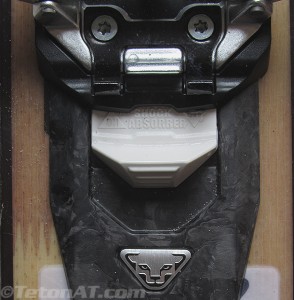 Shock Absorber– Another feature aimed at hard users, one is now able to choose between whether to have the binding’s toe and heel connecting plate “free-floating†or “locked outâ€. The “On†position aims to keep the distance between the toe and heel piece more static, which in turn helps reduce fore-and-aft pre-release when the ski is reverse flexed. The “On†position also engages some rubber ABS pads, which try to reduce the chatter when skiing on firm snow. I skied these bindings pretty aggressively in different variations of powder and corn snow and the ride was smooth, yet powerful.
Shock Absorber– Another feature aimed at hard users, one is now able to choose between whether to have the binding’s toe and heel connecting plate “free-floating†or “locked outâ€. The “On†position aims to keep the distance between the toe and heel piece more static, which in turn helps reduce fore-and-aft pre-release when the ski is reverse flexed. The “On†position also engages some rubber ABS pads, which try to reduce the chatter when skiing on firm snow. I skied these bindings pretty aggressively in different variations of powder and corn snow and the ride was smooth, yet powerful.
Pressed Carbon Plate– Stronger and more rigid than laid out carbon fiber, the plate locks into the toe-piece when in the “On” position, adding more torsional rigidity into the system.
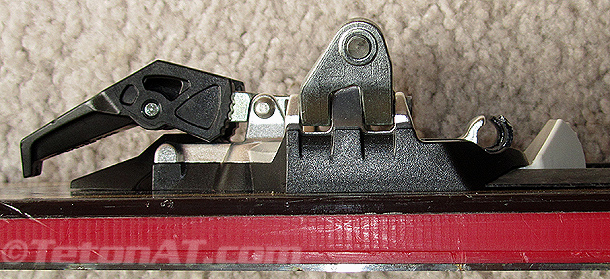
The plastic sub-plate not only stacks the binding, but also adds
some support to the aluminum plate on the sides.
6mm Stack Height– I’ve seen people make mounting shims out of cutting boards to use with their Dynafits, but I’ve never really felt the need for them. I guess an increased stack height allows for better leverage and edge power on firm snow though, as well as reduce toe-piece drag when on the groomers…which I can see as a plus for the FT version. Also of note is the 75mm effective width of the binding, which helps further still with power transmission on fatter skis.
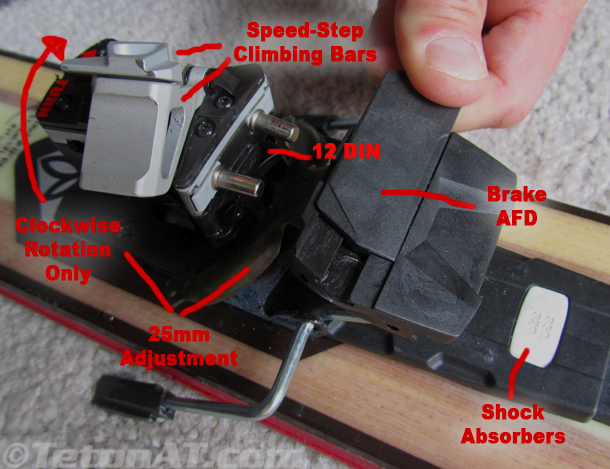
Dynafit Radical FT heel-piece.
Heel Piece
Brake AFD– For those that use Dynafit brakes, the AFD helps to allow for smoother and more consistent releases. These new brakes are compatible with Vertical and Comfort models of Dynafit bindings as well. I tend to forgo the use of brakes mainly to shave weight.
25mm Adjustment– It’s nice to have a good amount of adjustment for different boot sole lengths so you can use all the boots in your quiver with the same ski. I’ve had to remount bindings before when sizing for new boots with different BSLs which sometimes can be problematic depending on the location of the previously drilled holes. Adjustment=Good.
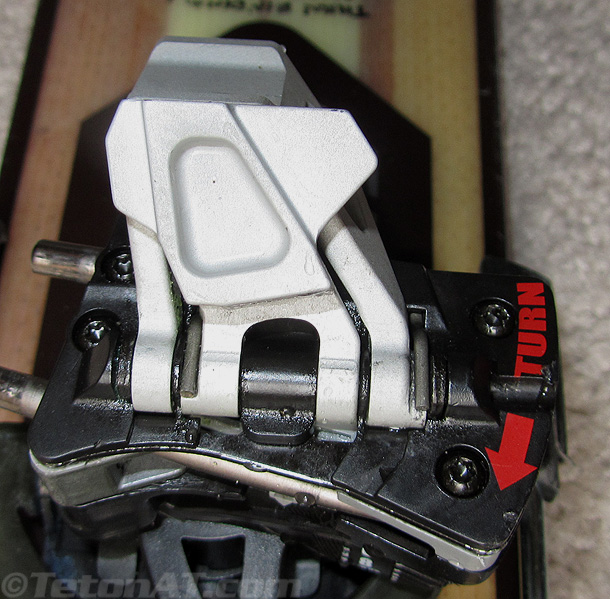
A small flange on the lowest heel post makes flipping it forward easier.
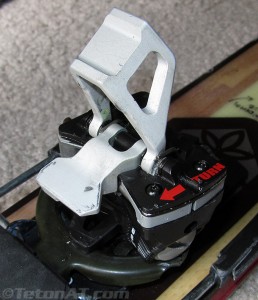 Speed Steep Climbing Bars– When the Click-Clack came out a few years ago, I ran out and got some, but ended up breaking them in a day or two. It was a cool concept, but a failure in design. This new rendition of the moveable heel posts looks to be quite beefier and the small tab on the lowest bar makes flipping it forward with your pole easier. Though moving the climbing bars forward was easy, I struggled a little with moving them backward with my ski pole. Mostly having trouble with the tallest post, it would sometimes only flip back halfway. I’m sure there is probably a better a technique than I was employing to flip them backward, but had a hard time figuring out what it was.
Speed Steep Climbing Bars– When the Click-Clack came out a few years ago, I ran out and got some, but ended up breaking them in a day or two. It was a cool concept, but a failure in design. This new rendition of the moveable heel posts looks to be quite beefier and the small tab on the lowest bar makes flipping it forward with your pole easier. Though moving the climbing bars forward was easy, I struggled a little with moving them backward with my ski pole. Mostly having trouble with the tallest post, it would sometimes only flip back halfway. I’m sure there is probably a better a technique than I was employing to flip them backward, but had a hard time figuring out what it was.
Clockwise Rotation– In an effort to address the problem that can sometimes happen when you are touring and your heel piece automatically rotates into ski more from touring mode (usually caused by the heel piece bumping against something or snow build-up), the Radical heel-pieces now only rotate in a clockwise direction. While it is nice not to have to worry about the “auto-rotate†problem, it does now require a full ¾ turn to move the heel-piece from tour-mode to ski-mode. You also can’t use your ski pole to rotate the binding anymore, so you will have to bend over or remove your skis to rotate it. I rarely have issues with the auto-rotate thing, so I have mixed feelings about the clockwise only rotation.
As resort accessed backcountry skiing becomes more and more popular, I can see the Radical FT being a really good choice for someone who wants to put a tech-style binding on a cross-over backcountry/resort setup. As a more weight conscious skier with mostly backcountry only skis, I’m looking forward to the TLT Speed Radical binding, which is a stripped down version of the FT. All and all, some of the changes in the Dynafit Radical bindings are welcome, yet some will take a Dynafit user of 15 years some time to adjust to. But I keep telling myself, change…is good.

a few questions….how much money? how much weight savings on the speed radicals?
thanks
What size Torx head?
“I have three sets of ski crampons in the closet”
Want to sell a pair? fit on old Verdicts?
Randosteve, What is a good way to fix the hole in your boot where you’ve clamped the DF toe into the boot material not the litle metal tech hole. I’ve tried epoxy but it doesn’t work too well. Thanks, (sorry for off topic.)
In that upper picture is that a bootpack that you are skinning in?
Nice review Steve.
Radical FT- 599g, w/ 110/130mm brake
Vertical FT- 530g, w/ 92/110mm brake
Radical ST- 531g, w/ 100m brake
Vertical ST- 520g, w/ 92mm brake
TLT Speed Radical- 341g (not sure if this is w/ or w/o the leash)
TLT Speed- 335g
i will get back regarding the prices…can’t find my price list right now.
sorry ted…but i still ski on skis around 100mm at the waist and not ready to part with the ski crampons just yet.
jim…randokitty has that on her spirit 3’s. have you tried p-tex, jb weld or even just melted plastic?
beaver…good observation. i just edited it so you can click on it and make it bigger.
actually it’s the skin track, but we stirred up some bighorn sheep higher up on our first lap…and they ran down and post-holed in the skin track. freakin’ sheep. 😉
http://tetonat.staging.wpengine.com/2011/04/16/doane-peak-east-ridge-couloir/
Radical FT- $599
Vertical FT- $559
Radical ST- $489
Vertical ST- $459
TLT Speed Radical- $399
TLT Speed- $369 (this year)
“I was still able to knock the lever down with my ski pole tip, but it was harder and I can see why Dynafit is trying to keep people from doing it.” The old KEEP PEOPLE FROM DOING IT design theory is funny. Not sure I’d notice the small “improvements” in the user experience. Certainly, I’d want a pair to play with.
love that dynafit are working on improvements. i’m all for the torx screws and reluctantly for the wider mounting platform (that 5th screw was dumb, and a wider platform is better — my only lament is that i wish i wouldn’t have to drill more holes if i choose to upgrade, but at some point they’ve got to introduce a new standard).
any sense on how much wider the screws will be vs. the current setup? (just want to do some calculations to see what my mounting options will be when i decide to make the plunge.)
i think the AFD on the heel is a weird solution to the problem of inconsistent release with a brake. in fact, i think it’s a bit of a cop-out; rather than fix the problem with the brake, they’re introducing another moving part.
also, i like the lower stack of the current models, though i’m sure 6mm isn’t a huge deal on snow. can’t quite tell from your pics if there’s a way to mount it without that stack without removing an integral piece of the new system.
minor gripes, but i’m overwhelmingly intrigued.
as for skiing it at a resort, it still seems to me that the key issue is not so much whether the binding can take it (it can), but rather that those skiing inbounds have come to expect bindings to release before their knees give. dynafit have addressed some key issues (more stable platform, vibration redux, etc.), but the key knee-friendly issue they still seem to lack is true release at the toe without a heel release (like in a backwards fall).
i personally ski dynafits without hesitation in any terrain, but i know that if i were to go down in that way, my knee’s going to suffer. many modern alpine bindings allow for the toe to release much more easily in these type of falls, and while not guaranteeing they’ll save your knee, the odds are much better.
thanks for sharing all these details.
chuck…that is just my impression and wording of course, and maybe not the real reason that they changed the design of the toe lever. BUT, i know that they don’t like when people use their pole tip to open the bindings, so reducing it’s size and shape from the vertical model is one way to address the broken toe lever issue.
eric…the TLT Speed Radical doesn’t have the extra 6mm of stack height.
i’m not sure exactly how much further apart the screws are now…sorry.
i think you can mount the toe pieces without the shim…but the rear one is part of the base plate…so that one stays. i don’t think they are that much taller than the current Vertical ST…but i don’t have any exact measurements.
I always flip my pole over and use the top of the grip to open the toe piece, rationalizing that it was worth the extra step not to break/wear out the Dynafit lever….
New holes are 12mm forward of the old holes according to Lou…..
As for the heel piece, can a pole tip fit in the hole of the largest climbing bar to rotate the binding back to ski mode?
Do you know if these bindings can be mounted on this years pre-drilled dynafit-skis? (e.g. Stoke or Mustagh Ata SLs?) Would you ski these bindings unlocked? (I have had prereleases on the current versions, and I am considering changing to radical to avoid that…)
Thanks Rob!
I was told that hole in the heel lever wasn’t meant for ski poles…and it looks like it would be hard to rotate the heel-piece 270 degrees with the pole angle that you’d have to use. I don’t have the binders anymore to try however.
I could never get into the habit of using my grip to open the toe…it just felt weird to me. If I’m not using my pole tip, then it’s usually the back of my hand or ski boot that opens them up.
christian…i think they can, but you might get screwed if you have a really big boot sole length, since the longer mounting pattern pushes the pins back 12mm.
as to whether i’d ski them unlocked? in some terrain…why not? i feel a big part of tech binding functionality regarding pre-release has to due with snow and ice getting into the system and mucking things up. since i’m lazy, i usually ski with them locked.
Christian – Yes you can use the current Dynafit skis with the Radical bindings. The new pattern matches up to the 1st and 4th toe inserts, or you can use the 3rd insert set and drill into the dimples forward of the inserts (may not be present on all skis this year but I know they’re on the Stokes at least).